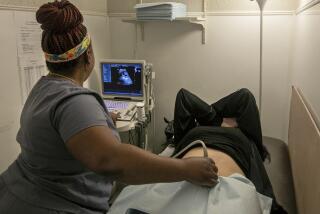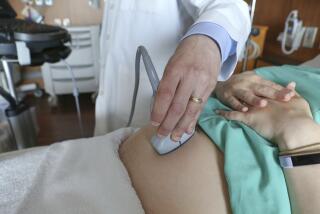Baby Machines : Pregnancy Has Gone High-Tech, Giving Women a Wide Array of Choices
- Share via
SUSAN HODGE will never forget the waiting. Though more than four months pregnant, she was still in limbo, waiting to find out if the fetus she carried bore the signs of a genetic defect. If it did, she and her husband would probably decide to terminate the pregnancy. Until then, she could barely admit to herself that she was pregnant. “I ignore the flutterings and kicks I feel,” she wrote at the time. “I talk of ‘if’ rather than ‘when.’ ”
That was in 1987. Hodge, a 40-year-old mother of two, was well aware of the ins and outs of prenatal genetic diagnosis--she taught genetics at UCLA Medical School. So she knew that at her age the risk of carrying a baby with a chromosomal abnormality, such as the one that could result in a child with Down’s syndrome, was much greater than when she had her first two children. But she did not know how very difficult the wait would be.
During amniocentesis, the doctor inserts a needle through the abdomen into the uterus and, using ultrasound to “see,” removes some of the fluid surrounding the fetus. The fetal cells in the fluid are then allowed to grow for about two weeks before being examined for certain genetic defects. Numerous studies during the past decade have verified that amniocentesis is a safe and accurate procedure. (The risk of miscarriage is as low as one in 200.) But this procedure is not typically performed until the 15th week of pregnancy, and by the time the results are available, the pregnancy is usually into the middle of the second trimester.
Fortunately, in the last two years, dramatic advances in prenatal diagnosis have significantly increased the number of prenatal tests available. One new test, chorionic villus sampling (CVS), has substantially decreased the waiting period; CVS can be done in the first trimester (generally between the eighth and 12th weeks), and preliminary results can be determined within a few days (though final results take about two weeks).
CVS is essentially a biopsy of the developing placenta. Guided by ultrasound, the doctor inserts a long, thin tube into the uterus through the vagina and uses the tube to snip off projections (villi) that emerge from the placenta. Some of these villi are subjected to a rapid form of chromosomal analysis for results that are available in a few hours, and the rest are put into cultures for a later, more precise diagnosis.
Several multicenter studies of CVS have proven it to be safe and accurate, though CVS carries more risk of miscarriage than amniocentesis (one to two in 100). CVS cannot, however, detect the possibility of a neural-tube defect, which can cause such conditions as anencephaly (the absence of all or part of the brain) and spina bifida. But because it can be performed earlier, CVS is the superior option for many women.
Choosing to have any test for prenatal diagnosis is an individual decision for each expectant mother or couple, says Steven Keiles, director of genetic counseling at Kaiser Permanente West L.A. “The bottom line is that these are optional tests,” he says. For some, he adds, the benefits of knowing about a genetic defect do not outweigh the slight risk of miscarriage.
CVS was available in 1987, but because it was still quite new, Susan Hodge decided that amniocentesis was the best choice. She recalls the grief she and her husband experienced when the results were “the dreaded ones”: the chromosomal abnormality associated with Down’s syndrome. To abort a wanted pregnancy during the second trimester, she says, was anguishing emotionally and a greater physical ordeal than an abortion in the first trimester would have been.
Ultrasound also may eventually offer an alternative to amniocentesis for some women. This technology, which provides many couples with their child’s first baby picture, in the form of a sonogram, uses high-energy sound waves to “see” into the uterus. Researchers at Brigham and Women’s Hospital in Boston recently reported that ultrasound conducted between 16 and 24 weeks of pregnancy could be extremely accurate in identifying fetal neural defects. Ultrasound is considered safe and is routinely performed by doctors to answer questions about a woman’s pregnancy--such as whether the due date is accurate or how many fetuses there are.
The decisions involving technological testing don’t stop with the prenatal period. The electronic fetal monitor is one of the most common technological devices in any hospital’s labor-and-delivery area, but its value is currently being questioned. This monitor, which measures the fetal heart rate and the regularity of the mother’s uterine contractions, consists of two belts that go around the woman’s abdomen, or one belt and an electrode placed on the fetal scalp. These are attached to the monitor, which gives doctors an early warning of fetal problems.
Recent studies conclude, however, that although monitoring is advisable for those women considered at risk for problem deliveries, there is no benefit for those who are low-risk. In light of those findings, some experts argue that electronic monitoring is an unnecessary intrusion, and that women should have a choice between it and the lower-tech fetoscope (similar to the stethoscope).
For now, most women do not have a choice about whether they will be electronically monitored. And many obstetricians, such as Dr. Marie Beall, who teaches and practices obstetrics at the UCLA Medical Center, believe that, in most cases, to rely solely on the fetoscope is impractical. “It requires one-to-one nursing for patients in labor, and this doesn’t happen,” Beall says. In almost every Los Angeles hospital, electronic monitoring is standard, Beall says, and many nurses don’t feel comfortable using a fetoscope, either because they don’t have the training or they don’t have the time during the birth to do it properly. If a woman really does not want to be hooked up, Beall says, she should begin to negotiate the option with her doctor early on in her pregnancy.
With all of the machinery and tests now available, pregnancy often seems almost too technological an experience. And in some ways, it may be. But overall, most of the new technology has contributed to making pregnancy a safer experience, in which there are clear choices. And even a difficult choice is better than an unknown but forgone conclusion--as was the case for Susan Hodge and her family. Two years after her abortion, she became pregnant again, and her third child is a healthy baby boy.






